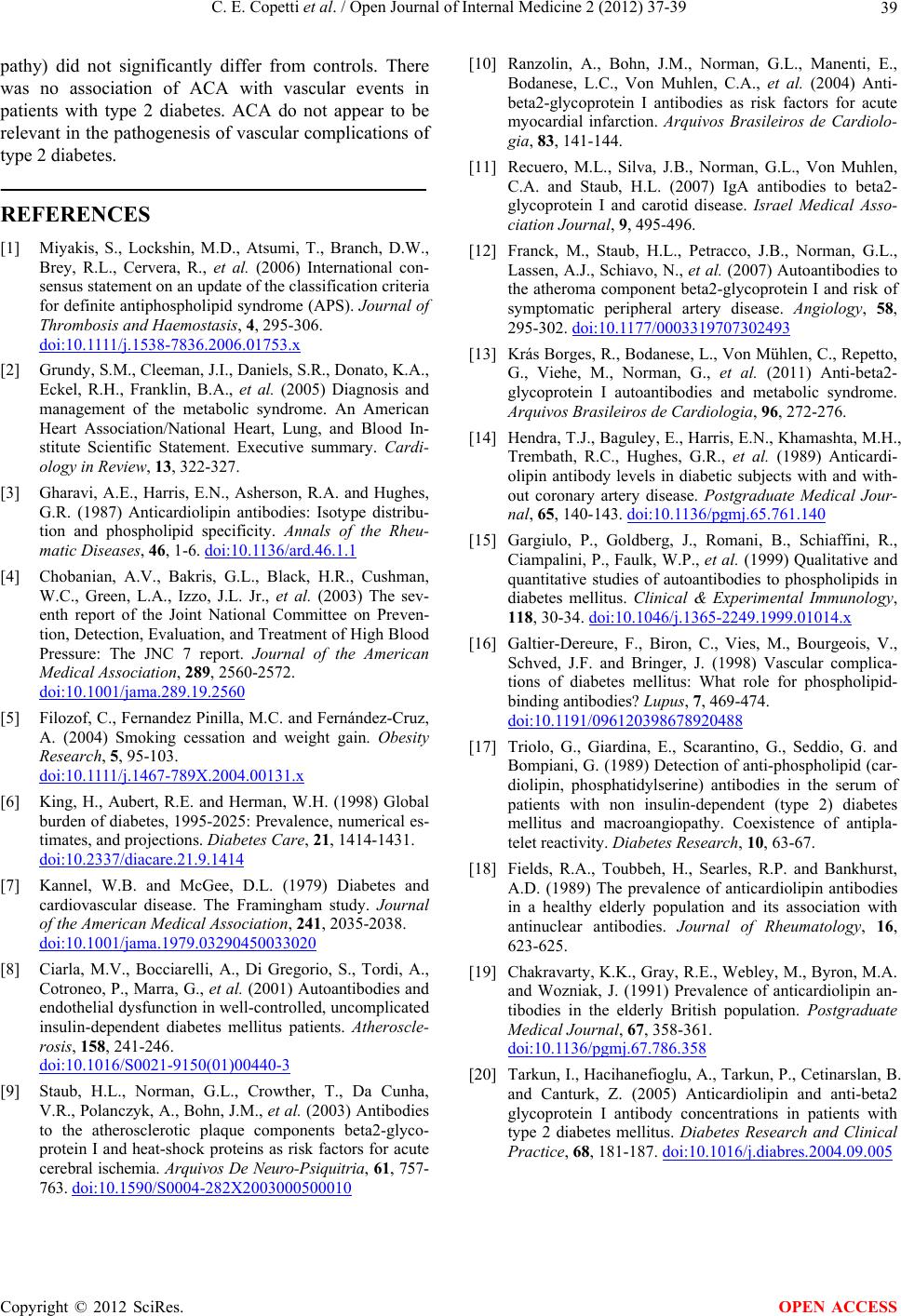
C. E. Copetti et al. / Open Journal of Internal Medicine 2 (2012) 37-39 39
pathy) did not significantly differ from controls. There
was no association of ACA with vascular events in
patients with type 2 diabetes. ACA do not appear to be
relevant in the pathogenesis of vascular complications of
type 2 diabetes.
REFERENCES
[1] Miyakis, S., Lockshin, M.D., Atsumi, T., Branch, D.W.,
Brey, R.L., Cervera, R., et al. (2006) International con-
sensus statement on an update of the classification criteria
for definite antiphospholipid syndrome (APS). Journal of
Thrombosis and Haemostasis, 4, 295-306.
doi:10.1111/j.1538-7836.2006.01753.x
[2] Grundy, S.M., Cleeman, J.I., Daniels, S.R., Donato, K.A.,
Eckel, R.H., Franklin, B.A., et al. (2005) Diagnosis and
management of the metabolic syndrome. An American
Heart Association/National Heart, Lung, and Blood In-
stitute Scientific Statement. Executive summary. Cardi-
ology in Review, 13, 322-327.
[3] Gharavi, A.E., Harris, E.N., Asherson, R.A. and Hughes,
G.R. (1987) Anticardiolipin antibodies: Isotype distribu-
tion and phospholipid specificity. Annals of the Rheu-
matic Diseases, 46, 1-6. doi:10.1136/ard.46.1.1
[4] Chobanian, A.V., Bakris, G.L., Black, H.R., Cushman,
W.C., Green, L.A., Izzo, J.L. Jr., et al. (2003) The sev-
enth report of the Joint National Committee on Preven-
tion, Detection, Evaluation, and Treatment of High Blood
Pressure: The JNC 7 report. Journal of the American
Medical Association, 289, 2560-2572.
doi:10.1001/jama.289.19.2560
[5] Filozof, C., Fernandez Pinill a, M.C. and Fernández-Cruz,
A. (2004) Smoking cessation and weight gain. Obesity
Research, 5, 95-103.
doi:10.1111/j.1467-789X.2004.00131.x
[6] King, H., Aubert, R.E. and Herman, W.H. (1998) Global
burden of diabetes, 1995-2025: Prevalence, numerical es-
timates, and projections. Diabetes Care, 21, 1414-1431.
doi:10.2337/diacare.21.9.1414
[7] Kannel, W.B. and McGee, D.L. (1979) Diabetes and
cardiovascular disease. The Framingham study. Journal
of the American Medical Association, 241, 2035-2038.
doi:10.1001/jama.1979.03290450033020
[8] Ciarla, M.V., Bocciarelli, A., Di Gregorio, S., Tordi, A.,
Cotroneo, P., Marra, G., et al. (2001) Autoantibodies and
endothelial dysfunction in well-controlled, uncomplicated
insulin-dependent diabetes mellitus patients. Atheroscle-
rosis, 158, 241-246.
doi:10.1016/S0021-9150(01)00440-3
[9] Staub, H.L., Norman, G.L., Crowther, T., Da Cunha,
V.R., Polanczyk, A., Bohn, J.M., et al. (2003) Antibodies
to the atherosclerotic plaque components beta2-glyco-
protein I and heat-shock proteins as risk factors for acute
cerebral ischemia. Arquivos De Neuro-Psiquitria, 61, 757-
763. doi:10.1590/S0004-282X2003000500010
[10] Ranzolin, A., Bohn, J.M., Norman, G.L., Manenti, E.,
Bodanese, L.C., Von Muhlen, C.A., et al. (2004) Anti-
beta2-glycoprotein I antibodies as risk factors for acute
myocardial infarction. Arquivos Brasileiros de Cardiolo-
gia, 83, 141-144.
[11] Recuero, M.L., Silva, J.B., Norman, G.L., Von Muhlen,
C.A. and Staub, H.L. (2007) IgA antibodies to beta2-
glycoprotein I and carotid disease. Israel Medical Asso-
ciation Journal, 9, 495-496.
[12] Franck, M., Staub, H.L., Petracco, J.B., Norman, G.L.,
Lassen, A.J., Schiavo, N., et al. (2007) Autoantibodies to
the atheroma component beta2-glycoprotein I and risk of
symptomatic peripheral artery disease. Angiology, 58,
295-302. doi:10.1177/0003319707302493
[13] Krás Borges, R., Bodanese, L., Von Mühlen, C., Repetto,
G., Viehe, M., Norman, G., et al. (2011) Anti-beta2-
glycoprotein I autoantibodies and metabolic syndrome.
Arquivos Brasileiros de Cardiologia, 96, 272-276.
[14] Hendra, T.J., Baguley, E., Harris, E.N., Khamashta, M. H.,
Trembath, R.C., Hughes, G.R., et al. (1989) Anticardi-
olipin antibody levels in diabetic subjects with and with-
out coronary artery disease. Postgraduate Medical Jour-
nal, 65, 140-143. doi:10.1136/pgmj.65.761.140
[15] Gargiulo, P., Goldberg, J., Romani, B., Schiaffini, R.,
Ciampalini, P., Faulk, W.P., et al. (1999) Qualitative and
quantitative studies of autoantibodies to phospholipids in
diabetes mellitus. Clinical & Experimental Immunology,
118, 30-34. doi:10.1046/j.1365-2249.1999.01014.x
[16] Galtier-Dereure, F., Biron, C., Vies, M., Bourgeois, V.,
Schved, J.F. and Bringer, J. (1998) Vascular complica-
tions of diabetes mellitus: What role for phospholipid-
binding antibodies? Lupus, 7, 469-474.
doi:10.1191/096120398678920488
[17] Triolo, G., Giardina, E., Scarantino, G., Seddio, G. and
Bompiani, G. (1989) Detection of anti-phospholipid (car-
diolipin, phosphatidylserine) antibodies in the serum of
patients with non insulin-dependent (type 2) diabetes
mellitus and macroangiopathy. Coexistence of antipla-
telet reactivity. Diabetes Research, 10, 63-67.
[18] Fields, R.A., Toubbeh, H., Searles, R.P. and Bankhurst,
A.D. (1989) The prevalence of anticardiolipin antibodies
in a healthy elderly population and its association with
antinuclear antibodies. Journal of Rheumatology, 16,
623-625.
[19] Chakravarty, K.K., Gray, R. E., Webley, M., Byron, M.A.
and Wozniak, J. (1991) Prevalence of anticardiolipin an-
tibodies in the elderly British population. Postgraduate
Medical Journal, 67, 358-361.
doi:10.1136/pgmj.67.786.358
[20] Tarkun, I., Hacihanefioglu, A., Tarkun, P., Cetinarslan, B.
and Canturk, Z. (2005) Anticardiolipin and anti-beta2
glycoprotein I antibody concentrations in patients with
type 2 diabetes mellitus. Diabetes Research and Clinical
Practice, 68, 181-187. doi:10.1016/j.diabres.2004.09.005
Copyright © 2012 SciRes. OPEN ACCESS